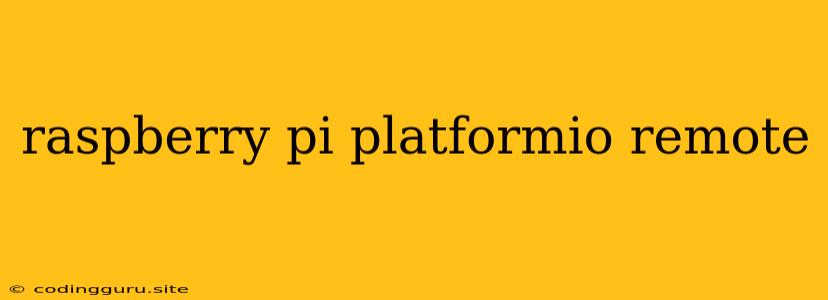Taming the Power of the Raspberry Pi with PlatformIO for Remote Control Projects
The Raspberry Pi is a versatile, affordable, and powerful microcomputer that can be used for a wide range of projects. From home automation and robotics to creating your own gaming consoles and media centers, the possibilities are endless. But what about controlling your Raspberry Pi project from a distance? This is where PlatformIO comes in.
PlatformIO is a professional, open-source platform for embedded development that simplifies the process of building projects on various microcontrollers, including the Raspberry Pi. It seamlessly integrates with your favorite code editor, offering a streamlined workflow for writing, building, uploading, and debugging your code.
Why Choose PlatformIO for Raspberry Pi Remote Control Projects?
- Simplified Setup: PlatformIO handles all the heavy lifting when it comes to setting up the development environment. You don't need to manually install a plethora of tools and libraries; it takes care of everything for you.
- Cross-Platform Compatibility: PlatformIO works seamlessly on Windows, macOS, and Linux, so you can develop your project on your preferred operating system.
- Powerful Features: PlatformIO provides powerful features like:
- Library Management: Easily search, install, and manage libraries for your project.
- Build Systems: Create robust build systems that automatically handle compilation and linking.
- Debugging Tools: Debug your code efficiently with integrated debugging capabilities.
- Community Support: PlatformIO has a thriving community of developers who contribute to its development and provide valuable support.
How to Get Started with PlatformIO and Raspberry Pi for Remote Control
Here's a simple example demonstrating how to use PlatformIO to set up a remote control project on the Raspberry Pi:
- Install PlatformIO: Download and install PlatformIO from the official website. You can choose to use the standalone version or install it as a plugin for your preferred code editor.
- Create a New Project: Open PlatformIO and create a new project. Choose the Raspberry Pi platform (typically based on the Raspberry Pi's processor, such as "Raspberry Pi Pico" or "Raspberry Pi 3") and select an appropriate framework (like "Arduino" for straightforward programming).
- Add Libraries: Depending on your project, you may need to add libraries for communication protocols like Bluetooth, WiFi, or other wireless options. PlatformIO makes it easy to search and install these libraries.
- Write Your Code: Write your code to control the Raspberry Pi's hardware components and send/receive data over your chosen wireless protocol.
- Build and Upload: Once your code is written, build and upload it to the Raspberry Pi using the PlatformIO interface.
- Remote Control Setup: Connect to your Raspberry Pi remotely using a compatible device (like a smartphone or computer) and send commands through your chosen communication protocol. You can use libraries like
pybluezfor Bluetooth orsocketfor network communication.
Example: Controlling an LED with PlatformIO
This simple example demonstrates how to control an LED connected to a Raspberry Pi GPIO pin using PlatformIO and a Bluetooth connection:
import platformio
import RPi.GPIO as GPIO
import bluetooth
# Define GPIO pin for LED
led_pin = 18
# Initialize GPIO
GPIO.setmode(GPIO.BCM)
GPIO.setup(led_pin, GPIO.OUT)
# Create a Bluetooth server
server_socket = bluetooth.BluetoothSocket(bluetooth.RFCOMM)
port = 1
server_socket.bind(("", port))
server_socket.listen(1)
print("Waiting for connection...")
client_socket, address = server_socket.accept()
print("Connected to ", address)
# Receive control commands
while True:
data = client_socket.recv(1024).decode("utf-8")
if data == "ON":
GPIO.output(led_pin, GPIO.HIGH)
client_socket.send("LED is ON".encode("utf-8"))
elif data == "OFF":
GPIO.output(led_pin, GPIO.LOW)
client_socket.send("LED is OFF".encode("utf-8"))
else:
client_socket.send("Invalid command".encode("utf-8"))
# Close the connection
client_socket.close()
server_socket.close()
Tips for Successful Remote Control with PlatformIO
- Security: When setting up remote control, remember to prioritize security. Avoid using open, unencrypted communication channels.
- Error Handling: Implement robust error handling in your code to gracefully handle unexpected events and prevent your project from crashing.
- Testing: Thoroughly test your remote control system in a controlled environment before deploying it in a real-world setting.
- Documentation: Keep detailed documentation of your code, hardware connections, and remote control setup for easy maintenance and troubleshooting.
Conclusion
PlatformIO offers a powerful and convenient way to develop remote control projects for your Raspberry Pi. By leveraging its features, you can simplify the development process, streamline code management, and build impressive projects that can be controlled from anywhere. Whether you're creating a home automation system, building a robot, or experimenting with wireless communication, PlatformIO is an invaluable tool for your Raspberry Pi endeavors.
